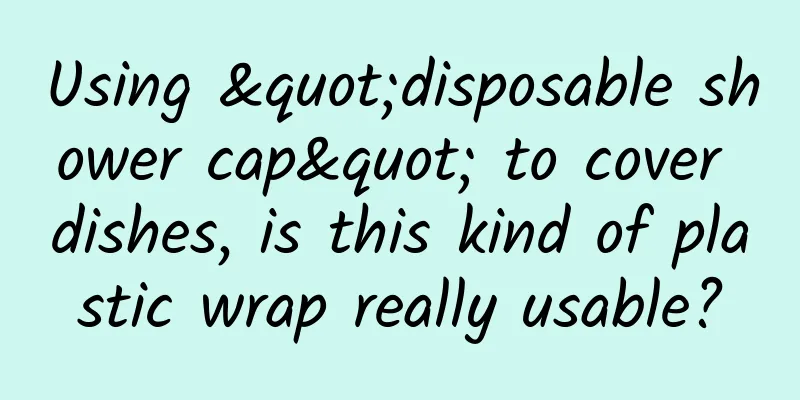Using "disposable shower cap" to cover dishes, is this kind of plastic wrap really usable?

|
In our home life, we use plastic wrap almost every day. Recently, a new shower cap-type plastic wrap has become very popular. Unlike the traditional tube-type plastic wrap that needs to be torn when used and may stick together, this new shower cap-type plastic wrap can be directly put on various plates and you can take one at a time when using it, which is very convenient. But it is said online that this kind of plastic wrap is actually a disposable shower cap or shoe cover, and contains excessive amounts of plasticizers, so it cannot be used to cover food. So can it still be used? Image source: Screenshot of e-commerce platform Let me first state the conclusion. When purchasing cling film, pay attention to the implementation standards of the product packaging. As long as it complies with the national standard GB 4806.7-2016 "National Food Safety Standard Plastic Materials and Products for Food Contact", you can use it with confidence. The national standard GB 4806.7-2016 requires that plastics used for food should mainly meet the migration rate requirements, that is, the chemical substances that migrate from plastic products to food should not exceed the standard to ensure safety. Like traditional cling film, shower cap-type cling film is made of low-density polyethylene (LDPE), which is a type of polyethylene (PE). This type of plastic does not require additional additives during processing and is not prone to migration. In other words, food packaged with this material is not easily contaminated, thus maintaining food safety. What are the materials of plastic wrap? Common food-grade cling film materials on the market include polyethylene (PE), polyvinyl chloride (PVC), polyvinylidene chloride (PVDC) and other biodegradable materials. We have summarized the material characteristics and precautions for use↓ Regarding the "plasticizer" issue that everyone is worried about causing cancer, polyvinyl chloride (PVC) cling film containing plasticizer (DEHP) does have certain risks, but as long as it does not come into contact with greasy food and is not heated, there is no need to worry. When using cling film, do not use polyvinyl chloride (PVC) cling film for foods that contain grease and need to be heated. This type of material can only be used to preserve fresh fruits and vegetables. Disadvantages of shower cap plastic wrap The principle of plastic wrap to keep food fresh is that it isolates bacteria and fungi, and also isolates oxygen to a certain extent, retaining moisture: Isolate bacteria and fungi: Plastic wrap acts as a physical barrier to prevent bacteria and fungi from contacting food and slowing down food spoilage. Reduce oxidation: Plastic wrap reduces food’s contact with oxygen and prevents oxidation reactions, such as discoloration of an apple after being cut. Keep moisture: Plastic wrap slows down the evaporation of moisture from food, keeping the food fresh and tasty. Copyright images in the gallery. Reprinting and using them may lead to copyright disputes. Therefore, the hidden danger of shower cap-type plastic wrap does not lie in the material itself. Compared with traditional cling film, the advantages of shower cap cling film are not so obvious when dealing with certain usage scenarios. For example, cut fruits are particularly fragile, but shower cap-type plastic wrap cannot wrap them tightly, and the elastic seal cannot completely seal the inlet and outlet of gases . As a result, the preservation time will be reduced. If you are also used to heating with a shower cap-type plastic wrap, there is a hidden danger in the shower cap: if the sealing part is an elastic band. Normally, it is wrapped in a layer of polyethylene (PE) and does not come into direct contact with food. However, if the polyethylene that wraps it breaks after heating, the elastic band will leak out. The materials used to make elastic bands are fibers such as nylon and spandex. They have good heat resistance themselves, but some additives need to be added during the processing, which may migrate into food and pose a threat to health. So, when choosing plastic wrap, it is important to pay attention to the type and safety of the material and avoid products containing harmful chemicals. When using it, follow the safety guidelines, especially the instructions regarding heating. Summarize: The new shower cap-type plastic wrap is very convenient, but consumers should be wary of some merchants selling ordinary plastic shower caps as plastic wrap, and understand the product's material, implementation standards and usage environment in advance. In addition, during specific use, you need to pay attention to: 1. When preserving particularly fragile foods, be careful not to keep them for too long. 2. When heating food in the microwave, remove the plastic wrap to avoid adverse effects. Planning and production Author: Sun Yafei, Distinguished Research Assistant at the Institute of the History of Natural Sciences, Chinese Academy of Sciences, PhD in Chemistry, Tsinghua University Review丨Sun Mingxuan, Professor of Shanghai University of Engineering Science Planning丨Fu Sijia Editor: Fu Sijia Proofread by Xu Lailinlin The cover image and the images in this article are from the copyright library Reprinting may lead to copyright disputes |
<<: A "weighing scale" in space: How to measure body mass in microgravity?
>>: A condiment that many people can’t stop eating and are addicted to. Thank you, Shanxi people!
Recommend
How does the epidemic affect the advertising industry?
The impact of the epidemic on industries such as ...
Volkswagen: In Q2 2022, Volkswagen's U.S. deliveries were only 78,281 vehicles, a year-on-year decrease of 34%.
Volkswagen's U.S. auto sales weakened further...
Hearty's six-week English writing course for postgraduate entrance exams
Those preparing for CET-8, those preparing for po...
With large-scale sandstorms approaching, how are sandstorms classified? What are the criteria for issuing sandstorm warnings?
Whenever the weather turns warmer, some relativel...
IBM's latest quantum computing progress: Is quantum computing's chatGPT moment coming soon?
In June 2023, IBM Quantum and its partners, inclu...
Your phone battery isn't durable? You may be doing these 5 things wrong
Some people say As long as the phone has power an...
Monument Valley design concept is learning is earning
We call those legendary, promising and unique com...
What is the configuration for renting a server in the education industry?
Education is a sunrise industry and the market de...
255 photons, 180 million times faster than classical computers, "Jiuzhang-3" is here to break the record!
On the 11th, a research team composed of Pan Jian...
Using 0.2 grams of lunar soil, they discovered a major secret
When conducting the first experiment with lunar s...
Shengtao E-commerce: 2022 anchor advanced training online column worth 980 yuan
Shengtao E-commerce: 2022 anchor advanced trainin...
5 tips for content product operations
A few days ago, "Wolf Warrior 2" ushere...
Your headphones are about to be "disrupted" by AI: Just take a look and the whole world is filled with his voice
Modern life is noisy in most situations. If you d...
Use these 3 methods to impress your users
Before starting the article, let's do a small...
The new media marketing logic behind Wang Ju's sudden popularity in "Produce 101"
Recently, Tencent Video ’s self-produced star-dev...









